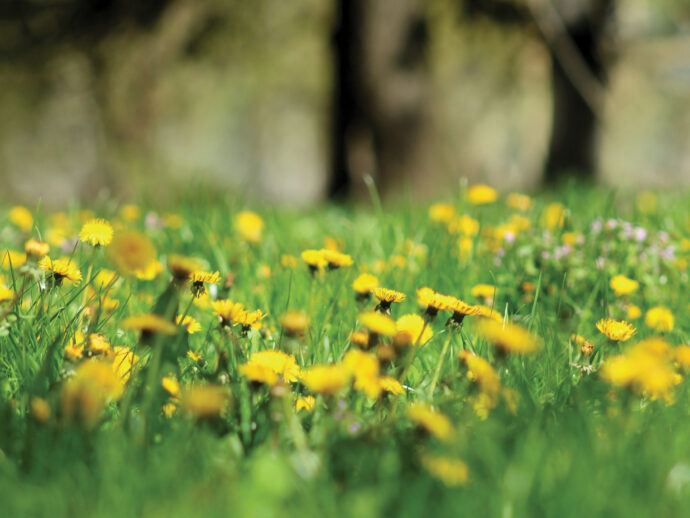
They’re the whole plant deal. Not only are dandelion leaves delicious and wholesome in your salads and soups, but the blossoms (wine) and roots (coffee) are also great sources of health-giving nutrients.
Why not?
- they’re high in calcium
- they’re a good source of iron, zinc, and potassium
- they’re filled with vitamins A, C, K, and the Bs
- they’re ubiquitous!
Harvest ’em!
First order of business: stay clear of dandelions if you’re not absolutely sure they haven’t been exposed to fertilizers, herbicides, pesticides, or any other chemical contaminants.
Best spots
- meadows, pastures, open spaces
- areas cleared of wild vegetation—dandelions thrive in cultivated soil
- crevices—as the wind carries their seeds, some hit walls and fences, drop, and take root; they’re small and can settle into tight spaces
- shadier areas, where growth is delayed, harbour younger, less bitter leaves
Best times
- springtime, before or as the dandelion flowers bloom
- late fall—after the first frost, the plant’s bitterness diminishes
- if picked between these times, blanch the leaves to temper bitterness
- sunny days—flowers close during rainy, cloudy weather so they’re harder to spot
Best to avoid
- areas where dangerous chemicals, pesticides, or herbicides may have drained into the soil—even your own lawn if chemicals might have been used on it
- roadsides that could be contaminated by exhaust fumes and winter salting
- parkland where dogs and other animals run free; always wash leaves thoroughly, twice
For the leaves
- pick young, tender leaves (they’re less bitter)
- use in salads and soups instead of spinach
Tip
Toss and dress ’em
- For salads
- If picked when their shiny, green leaves first appear in spring, dandelion leaves add a sharp zing to salads. However, the word bitter dominates descriptions of their taste.
- To mute bitterness, recipes recommend blending the leaves with other vegetables—lettuce, endive, and shallots—then adding nuts, cheese, and vinaigrette dressing.
- The crisp leaves also deliver a sandwich with bite when placed between buttered whole wheat slices and sprinkled with salt, pepper, and lemon juice.
For vegetable and pasta dishes
- Blanching the leaves in boiling, slightly salted water tempers the taste when they’re really bitter.
- Sautéeing them for two to four minutes more in olive oil, lemon juice, and crushed garlic produces a result similar in flavour and texture to spinach.
- Tossing the cooked dandelion leaves into vegetable and pasta dishes adds a fresh twist to everyday menus.
For the roots
- choose mature plants (they have bigger roots)
- drive a pitchfork firmly into the ground, avoiding the root, tipping backward to lift and loosen the soil, then grip below the leaves and pull up gently
- trim, clean, chop, and store in fridge
- steep for tea or roast and use as a coffee substitute (see alive.com for our delicious Dandelion Cinnamon- Spiked Iced Coffee recipe)
Roast and sip ’em!
- Spring dandelion roots are best for making tea or coffee. Dig them before the aerial portion of the plant develops.
- Scrub the root clean, split lengthways, and steam for 5 minutes or so to congeal the root sap.
- Cool and chop into small pieces and place in a 300 F (150 C) oven with the door slightly ajar to allow moisture to evaporate.
- When they’re a nice chocolate brown and crackling dry, remove and cool.
- To make your beverage, grind in a coffee grinder and use 1 tsp (5 mL) per cup (250 mL) of boiling water.
For the blossoms
- pick when they’re bright yellow and young
- use them fresh—without the stems—in salads, for wine, or sautéed in butter



































